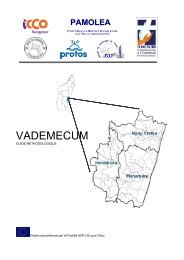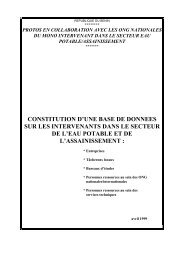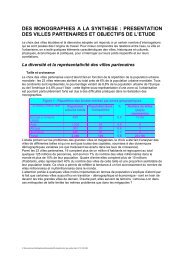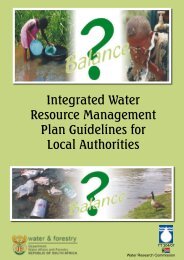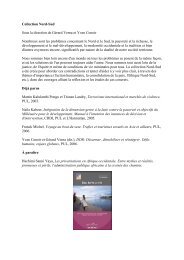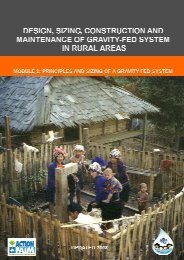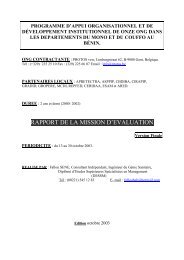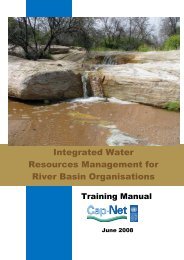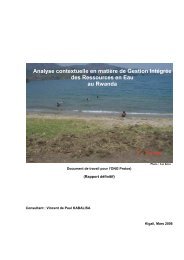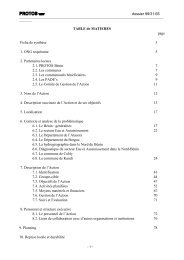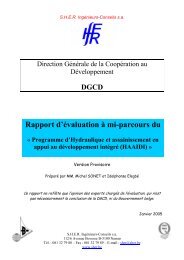table of contents preamble 1. summary - ACT - Advanced ...
table of contents preamble 1. summary - ACT - Advanced ...
table of contents preamble 1. summary - ACT - Advanced ...
You also want an ePaper? Increase the reach of your titles
YUMPU automatically turns print PDFs into web optimized ePapers that Google loves.
The hygiene and sanitation component that SOCADIDO grafted on his drinking water<br />
interventions is also relevant since the link between safe water, hygiene, sanitation and health<br />
is so important. However the interest <strong>of</strong> the target groups for this hygiene and sanitation<br />
component is rather low, partly due to lack <strong>of</strong> education and comprehensive integrated health<br />
and sanitation programmes.<br />
At the end <strong>of</strong> 1996, the project started with one year delay. A completely new staff has been<br />
recruted and trained, partially by the Ugandan <strong>of</strong>fice <strong>of</strong> Water Aid. The first year was<br />
especially devoted to the development <strong>of</strong> the programme approach and <strong>of</strong> the skills <strong>of</strong> the staff<br />
members. Some constructions have been implemented during this time but with a limited<br />
conviction. It’s only from the beginning <strong>of</strong> ’98 on that the cruising speed has been reached for<br />
the technical interventions and that the community mobilisation and the hygiene and<br />
sanitation component started.<br />
Due to the badly managed experimental phase and formulation process, the project file is not<br />
always realistic or sufficiently detailed. It overestimates the implementing capacities <strong>of</strong> the<br />
whole new staff SOCADIDO had to hire (and to train) and it underestimates some actual<br />
construction costs. On the other hand, the data and approaches developed for the s<strong>of</strong>tware<br />
components remained vague; they had to be worked out during a start up seminar that only<br />
took place in August ’97.<br />
After two years, the quantitative results are only partially achieved. Only 44 water points have<br />
been improved (out <strong>of</strong> the 88 projected for the first two years) : 25 springs and 19 handaugured<br />
wells equipped with a handpump (instead <strong>of</strong> the planned shallow wells). Most <strong>of</strong><br />
those waterfacilities have now water users committees but only a few are really performant. In<br />
total about 13.000 persons have been reached by the project.<br />
The quality <strong>of</strong> the constructions has improved a lot during these two years and, with respect to<br />
the water quality and the viability <strong>of</strong> the construction, one can confirm a good quality <strong>of</strong><br />
works regarding the Ugandan standards. Improvements are still possible with more important<br />
excavating works and the protection <strong>of</strong> a more important catchment area for the springs.<br />
Until now, no filter appendage has been completed. The whole approach has to be reviewed.<br />
This experiment has to be treated as such with a sound planning, in transparency with the<br />
community and with a very close monitoring in order to learn lessons on this technology and<br />
its integration in the local social context.<br />
In order to enhance community ownership and sustainability, the community is involved in all<br />
stages <strong>of</strong> the project. The target group is informed on its roles and responsibilities. It<br />
contributes all local materials, designs volunteers to be trained by the masons and guarantees<br />
all unskilled labour. Water source committees are elected by the users and trained in<br />
leadership skills and simple financial management.<br />
Women make up for about 40% <strong>of</strong> the members <strong>of</strong> the committees and in different places they<br />
have an important contribution in the mobilisation and the decision making.<br />
The hygiene and sanitation component started only very late, but nevertheless in most villages<br />
the start <strong>of</strong> a mentality change can already be noticed. One <strong>of</strong> the most important surplus<br />
values <strong>of</strong> the project is the integrated approach <strong>of</strong> this hygiene component.<br />
6




